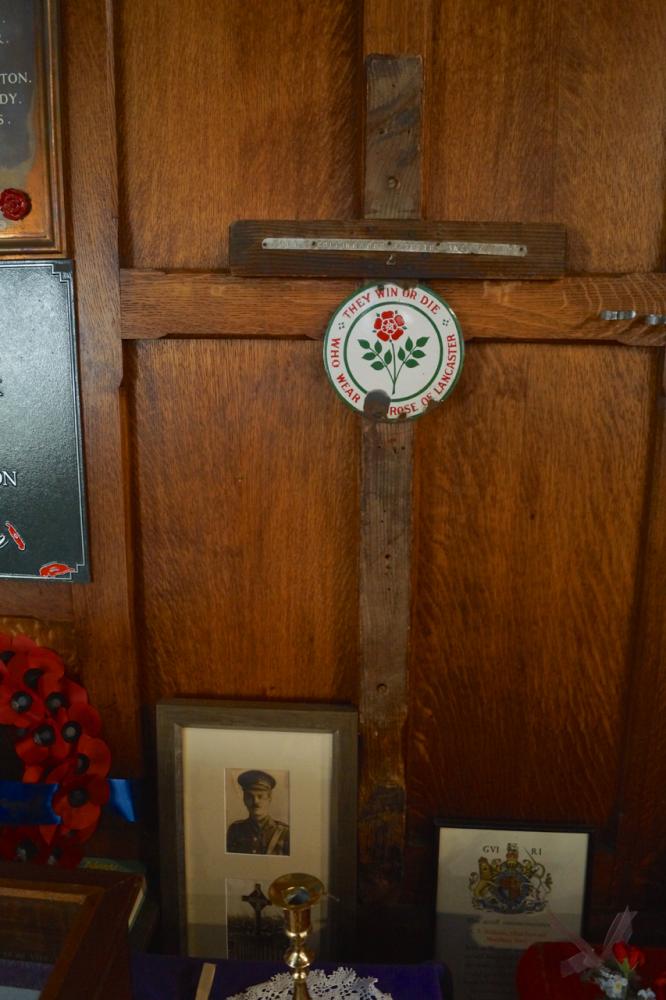Wigan Album
War Memorials
3 Comments
Photo: Rev David Long
Item #: 31858
Even greater rarity is added by the survival of the damaged white enamelled metal roundel attached below the cross piece. This has the red rose of Lancaster at its centre and the motto of the 55th (West Lancashire) Division Territorial Force around the outside between green rings. This 'cocarde de souvenir' was placed on the graves of all the men from the Division, and was funded by an appeal, The Grave Identification Fund, launched among the surviving officers and men in August 1918. They were priced at 2 shillings (10p) each.
To the left of the cross may be seen a frame with two photographs - one of the Captain, the other of the original, more elaborate, cross placed on his grave in 1916. The Germans retook the area of his grave in 1918, so that was probably destroyed in the fighting - and replaced with the simpler one here.
thir are 7 of thease in cavindish suffolk cliff
4th Prince of Wales’ Volunteers (South Lancashire Regiment)
Killed in Action 8th August 1916 Age 26.
"According to the “Newton and Earlestown Guardian” issue of August 18th 1916, Captain Carlton Collingwood was born in October 1889 and was the eldest son of Mr. and Mrs. William Collingwood, whose Essex address was “The Grove, Dedham”. Educated at Charterhouse, he was for three years in succession a member of the Shooting Eight, and in 1907 captained it to second place for the Ashburton Shield. He also represented his school as a featherweight in boxing at Aldershot.
He served his apprenticeship in engineering at Armstrong and Whitworth’s, Manchester, and then went to the Vulcan Foundry Co., Newton-le-Willows, where he was appointed assistant manager.
In July, 1913, he married May, the youngest daughter of the late Alexander Cavendish and of Mrs. Cavendish, Finchampstead, Berkshire. His death leaves a widow and a son. Mrs. Collingwood’s brother, Major H. C. Cavendish, was killed in the same week as her husband.
Captain Collingwood entered the 4th South Lancashire (Territorial) Regiment in 1909, and resigned in 1913. He joined the South Lancashires again on August 3rd 1914, and got his Lieutenant’s commission on August 26th 1914. He went to France with the Battalion in early 1915, but was invalided back home in the April. He again filled his position of Assistant Works Manager at the Vulcan Foundry. However, his health broke down again, and he had to go into hospital. On regaining his strength, Lieutenant Collingwood again joined up, and returned to the front in April 1916 with a Captain’s commission.
He was wounded at about 4-30 a.m. on August 8th 1916, and died on reaching the Dressing Station. Sergeant Major Wheeler and four of his men carried him to the Dressing Station as soon as he was wounded, gallantly risking their own lives to do so.
Captain H. Whalley-Kelly, in his book “Ich Dien”, gives an account of the circumstances surrounding Captain Collingwood’s death:
“On 7th August a local attack on Guillemont village was made by troops of the 55th Division, and “D” Company of the Battalion was attached to the 164th Infantry Brigade for the operation. “D” Company was divided into two, the right half under Captain C. Collingwood and the left under Second-Lieutenant G. C. Coury, working in conjunction, respectively, with the 1st/8th King’s and 1st/4th King’s Own. In each case the role of the Pioneer parties was to dig communication trenches from the newly-captured positions back to our original line; a task involving great risks, as the troops had to work in the open, swept by machine-gun and shell fire.
“At 4.20 a.m. the attack went forward, closely followed by the two half companies of the 1st/4th, their Lewis gunners providing local covering fire. To describe the confused fighting that followed is outside the scope of this chronicle, suffice it to say that the assault broke down, but not before the right half company had constructed sixty yards of communication trench, while the left half company had dug, in one hour, a hundred yards of trench five feet deep; a magnificent effort on the part of “D” Company which cost it 2 officers (including Captain Collingwood) and 6 other ranks killed, and 1 officer and 47 other ranks wounded, plus 5 other ranks missing.”
Cliff - there's a website which has been set up to trace all the battlefield crosses which came back to Britain - the distribution around the country is irregular: ttp://thereturned.co.uk